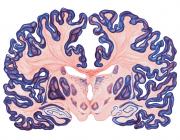Methods for functional magnetic resonance imaging in normal and lesioned behaving monkeys.
Publication Year
2005
Type
Journal Article
Abstract
Methods for performing functional magnetic resonance imaging (fMRI) studies in behaving and lesioned monkeys using a human MR scanner are reported. Materials for head implant surgery were selected based on tests for magnetic susceptibility. A primate chair with a rigid head fixation system and a mock scanner environment for training were developed. To perform controlled visual studies, monkeys were trained to maintain fixation for several minutes using a novel training technique that utilized continuous juice rewards. A surface coil was used to acquire anatomical and functional images in four monkeys, one with a partial lesion of striate cortex. High-resolution anatomical images were used after non-uniform intensity correction to create cortical surface reconstructions of both lesioned and normal hemispheres. Our methods were confirmed in two visual experiments, in which functional activations were obtained during both free viewing and fixation conditions. In one experiment, face-selective activity was found in the fundus and banks of the superior temporal sulcus and the middle temporal gyrus in monkeys viewing pictures of faces and objects while maintaining fixation. In a second experiment, regions in occipital, parietal, and frontal cortex were activated in lesioned and normal animals viewing a cartoon movie. Importantly, in the animal with the striate lesion, fMRI signals were obtained in the immediate vicinity of the lesion. Our results extend those previously reported by providing a detailed account of the technique and by demonstrating the feasibility of fMRI in monkeys with lesions.
Keywords
Journal
J Neurosci Methods
Volume
143
Pages
179-95
Date Published
04/2005
ISSN Number
0165-0270
Alternate Journal
J. Neurosci. Methods
PMID
15814151

